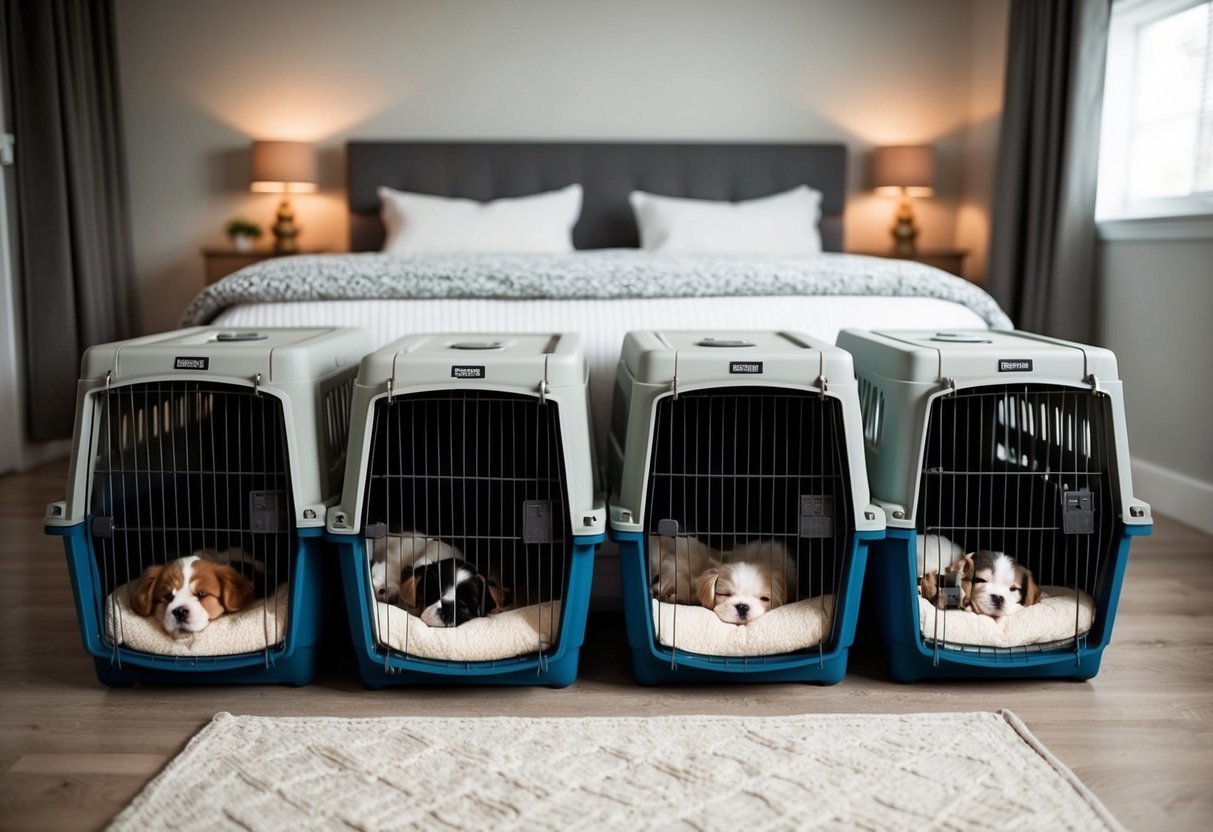Crate training can be a challenge, especially when your puppy won’t stop crying at night.
Many pet owners find themselves dealing with sleepless nights as their new furry friend adjusts to their crate. Using effective crate training tricks can help you reduce or eliminate this nighttime crying, allowing both you and your puppy to get better rest.
There are several strategies that can make crate training easier and more enjoyable for your puppy.
By establishing a consistent routine and using positive reinforcement, you can help create a safe and comfortable space for your pet.
In this article, you’ll discover four practical tricks that will help you handle nighttime crying and make crate training a smoother process for everyone involved.
Use a snuggle puppy with a heartbeat inside
A Snuggle Puppy can be a great help for your new puppy at night.
This stuffed animal comes with a heartbeat feature that mimics the feeling of being with their mother and littermates.
When you place the Snuggle Puppy in the crate, the heartbeat can soothe your puppy.
It creates a comforting environment that may help them feel less anxious and alone.
The gentle pulse can remind them of their time with their family before you brought them home.
Additionally, this toy often includes a heat pack.
The warmth can make it feel even cozier for your puppy.
This combination of warmth and a heartbeat can encourage your puppy to settle down and sleep better through the night.
Many puppy owners find that using a Snuggle Puppy reduces crying.
It’s a simple tool that can make a huge difference in your puppy’s crate training experience.
If your puppy struggles with nighttime separation, consider giving this calming aid a try.
Introduce a cozy chew toy for bedtime
A cozy chew toy can make a big difference for your puppy at night.
It gives them something safe to focus on while settling down.
Choose a toy that is soft and easy to chew.
Consider toys without squeakers, as they might keep your puppy awake.
A quiet toy promotes a calm environment.
You can even try toys that can be filled with treats, making it more engaging.
When you introduce the chew toy, place it in the crate before bedtime.
This way, your puppy can explore it and get comfortable.
It can help create a positive association with the crate.
If your puppy gets too excited, you might need to take it away at bedtime.
Always supervise playtime to ensure the toy remains safe.
A cozy chew toy can help ease nighttime anxiety for your pup.
It can also keep them entertained, making it easier for them to drift off to sleep.
3) Play soothing music or white noise

Playing soothing music or white noise can really help your puppy settle down at night.
This type of sound can mask outside noises that might disturb them.
White noise machines are easy to find and work well to create a calming environment.
You can also use a fan or an app that plays ambient sounds.
Many pet owners find that soft music made for dogs keeps their pets relaxed.
There are even playlists and videos dedicated to this purpose.
Try playing these sounds softly in the background as you put your puppy to bed.
This way, they can associate crate time with comfort and peace.
Using soothing sounds can make a real difference in how your puppy adapts to their crate.
It’s a simple trick that can reduce crying and help your furry friend feel safe.
4) Cover the crate with a breathable blanket

Covering your dog’s crate with a breathable blanket can help reduce night crying.
It creates a cozy and den-like environment that many dogs find comforting.
Make sure the blanket is soft and allows for good airflow.
This keeps your dog from getting too hot or stuffy inside the crate.
Some dogs really like the security of a covered space.
You can try draping the blanket over just the back half of the crate.
This gives your dog a dark spot to settle down while still providing some openness.
Watch your dog’s reactions.
If they seem more relaxed, it’s a good sign the cover helps.
If they seem restless, you might want to try leaving part of the crate uncovered.
Remember that covering the crate too tightly can lead to overheating.
Always check the temperature inside.
A breathable blanket can provide comfort, but safety is key!
Understanding Nighttime Crate Anxiety

Many puppies experience anxiety when it’s time to sleep in their crates at night.
Recognizing the signs and understanding the reasons behind this behavior can help you manage it effectively.
Signs of Crate Anxiety
Look for specific behaviors that may indicate your puppy is feeling anxious in the crate.
Common signs include:
- Crying or Whining: Vocalizing can be the first sign of discomfort.
- Pawing at the Crate: Your puppy may scratch or paw at the door, trying to escape.
- Restlessness: If your puppy is moving around a lot or unable to settle down, this can indicate unease.
- Drooling or Panting: Excessive drooling or heavy panting can also be indicators of stress.
Pay attention to these signs, as they can help you determine the severity of your puppy’s anxiety.
Common Causes of Night Crying
Several factors may contribute to your puppy’s night crying.
Understanding these causes can provide clarity:
- Separation Anxiety: Your puppy may feel lonely away from you or their littermates.
- Lack of Familiarity: A new crate might seem scary at first, especially in a different environment.
- Need for Potty Breaks: If your puppy is very young, they may not yet be able to hold it through the night.
- Boredom or Excess Energy: Puppies are active creatures. If they haven’t been exercised enough during the day, they may feel restless at night.
Identifying what triggers your puppy’s anxiety can help you create a more comfortable sleeping situation.
Creating a Comfortable Crate Environment

To help your puppy feel safe and secure in their crate at night, you’ll want to focus on the crate’s size and bedding.
These elements play a big role in creating a cozy space that encourages a sense of comfort.
Choosing the Right Crate Size
Picking the right size crate is key.
If it’s too small, your puppy will feel cramped.
If it’s too big, they might use one corner as a bathroom.
A good rule of thumb is to choose a crate that’s just big enough for your puppy to stand up, turn around, and lie down comfortably.
You can measure your pup’s length and height when they’re sitting or standing.
Consider using a crate divider if you plan to get a larger crate as your puppy grows.
This allows you to adjust the space as they get bigger, helping them feel secure from the start.
Adding Cozy Bedding
Cozy bedding can make a big difference in how your puppy feels about their crate.
Choose bedding that is thick and soft to provide comfort.
Look for materials that are washable to make cleaning easy.
Options for bedding include:
- Blankets: Soft blankets can add warmth and comfort.
- Dog beds: Ensure they fit snugly inside the crate.
- Towels: These can be a good temporary option.
Adding a favorite toy or a worn-out piece of clothing can also help.
The familiar scent will comfort your puppy and make them more likely to settle in for the night.
Building a Calming Crate Routine

Creating a calming crate routine can help your puppy feel more secure and reduce nighttime crying.
Consistency and comfort are key to making this transition easier for both you and your dog.
Establishing a Pre-Bedtime Ritual
Develop a pre-bedtime ritual that signals it’s time to wind down.
This could include activities like a gentle walk or some quiet playtime.
Aim to keep this routine consistent every night.
Key steps:
- Set a specific bedtime: Stick to the same time each night to create predictability.
- Calm activities: Engage in activities that relax your puppy, like light cuddling or gentle petting.
- Bathroom break: Always take your puppy out for one last bathroom break before bedtime to prevent accidents.
This routine helps your puppy associate certain activities with going into their crate, making it a more peaceful experience.
Using Soothing Sounds or Toys
Consider incorporating soothing sounds or comforting toys in the crate.
Background noise can drown out other distractions and make your puppy feel safe.
-
Soft music or white noise: Play calming music or a white noise machine to provide a steady sound that helps relax your puppy.
-
Chew toys or stuffed animals: Provide interactive toys that can keep your puppy occupied. Choose toys that are safe and offer comfort.
Using these soothing elements in the crate can help create a safe and calm environment that reduces anxiety during the night.
Frequently Asked Questions

Helping your puppy settle down in their crate at night can be tricky.
Here are answers to common questions to help you manage crying and create a more peaceful environment.
How can I soothe my puppy crying in the crate at night?
You can try using a snuggle puppy with a heartbeat inside.
This helps mimic the comfort of their mother.
Adding a cozy chew toy can also give your puppy something soothing to focus on during the night.
What’s the best way to handle a puppy that screams in the crate for hours?
If your puppy is screaming, stay calm.
It’s important to avoid giving in too quickly.
Instead, offer comfort items like a blanket or soft toy.
You can also play some soothing music or white noise to help relax them.
How many nights is it normal for a puppy to cry in the crate during training?
Typically, it’s normal for puppies to cry for a few nights.
Expect this for about one to two weeks.
This timeline can vary based on the puppy’s temperament and how well they’re adjusted to the crate.
Are there any effective tricks to stop a puppy from crying when crate training?
Yes, several tricks can help.
Playing soothing music can reduce anxiety.
Covering the crate with a breathable blanket can create a cozy, den-like space that feels safe to your puppy.
What should I do if my puppy won’t stop crying in the crate at night?
If your puppy won’t stop crying, check if they need to go potty.
If not, try using calming techniques like a heartbeat toy or gentle music.
Stay consistent with your training approach to help them feel secure.
At what point should I check on my puppy if they’re crying in the crate?
Wait a few minutes before checking on your puppy.
If the crying continues, you can check after about 5 to 10 minutes.
This helps teach them to settle down on their own while ensuring their needs are met.

